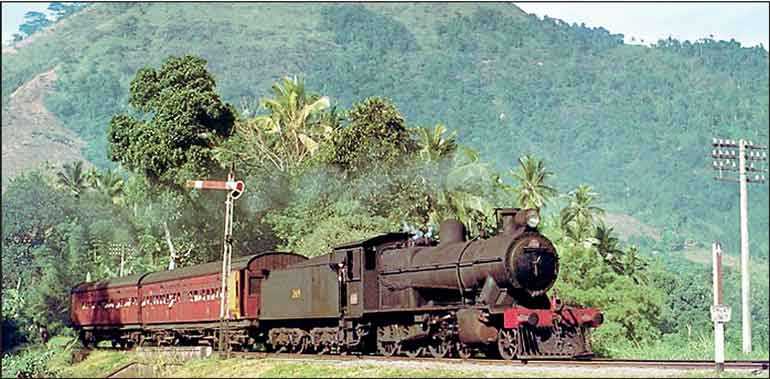Monday Mar 03, 2025
Monday Mar 03, 2025
Saturday, 15 February 2020 00:05 - - {{hitsCtrl.values.hits}}

 In the newspapers earlier this week, seeing a train using a steam engine stopped at the Fort Railway Station carrying tourists brought back memories when as schoolchildren we came to Ananda by train from Gampaha to Colombo in the late 1940s/early 1950s. Quite a number used the train after Ananda branch at Gampaha, which opened during the war years, was closed and everyone had to come to the main school at Maradana.
In the newspapers earlier this week, seeing a train using a steam engine stopped at the Fort Railway Station carrying tourists brought back memories when as schoolchildren we came to Ananda by train from Gampaha to Colombo in the late 1940s/early 1950s. Quite a number used the train after Ananda branch at Gampaha, which opened during the war years, was closed and everyone had to come to the main school at Maradana.
It was the steam engine era. Each engine carried a name board of either a British Governor or a leading Colombo school. As Anandians we used to look for engine number 273 which carried the Ananda College tag. Royal College was number 270. I cannot recollect the other names.
During the university days we used to shuttle between Gampaha and Peradeniya by train when the university closed for vacation. The train stopped at Rambukkana when the engine was pulled out and taken to fill water. After it was brought back a second engine was fixed at the rear to push the train during the Kadugannawa hill climb. The scenery in that stretch was fascinating with greenery on either side coupled with a range of mountains.
Along with the engine driver were two assistants – one to assist him in driving and the other to ensure that sufficient firewood was put in to maintain the heat. This was how the train was described as ‘Anguru kaka vathura bibi – Kolamba duwana yakada yaka’ – the metal devil who runs to Colombo eating charcoal and drinking water.
Small traders selling ‘masala vadai’, ‘ulundu vadai’ and other tit bits had a good sale during the break at Rambukkana. They used to sell their stuff walking from one end of the platform to the other shouting what they were offering. In fact, the place became famous for ‘vadai’ because of the sales.
It was over 150 (162 to be exact) years ago that the railway system was started in Ceylon – as Sri Lanka was then known. It was during the British administration and the reason for opening the railway was because of the interests of the British planters to transport tea and coffee from the hill country to Colombo to be shipped to UK.
The service had begun with a 54 kilometre (34 miles) main line connecting Colombo and Ambepussa – a place that is very popular to date with motorists going to and from Colombo to Kandy. The buses stop there for the passenger to have a bite and a warm cup of tea. The rest-house is one of the most popular ones in Sri Lanka for a sumptuous lunch and a good break.
It has been recorded that the rail track gauge was 676 mm (5 ft. 6 ins.) with a track length of 1,608 km. At a peak of 1,900 metres (6,200 ft.) Sri Lanka has the most elevated broad-gauge railway in the world, Sri Lanka Railways says.
The current official figures mention that 300,000 passengers travel daily on 324 trains between 320 stations across the country.
The change from steam locomotives to diesel took place in 1953. It happened when B.D. Rampala (a name synonymous with the local railway due to his long and courageous service) was General Manager, as the head of the Railway was known.
Discover Kapruka, the leading online shopping platform in Sri Lanka, where you can conveniently send Gifts and Flowers to your loved ones for any event including Valentine ’s Day. Explore a wide range of popular Shopping Categories on Kapruka, including Toys, Groceries, Electronics, Birthday Cakes, Fruits, Chocolates, Flower Bouquets, Clothing, Watches, Lingerie, Gift Sets and Jewellery. Also if you’re interested in selling with Kapruka, Partner Central by Kapruka is the best solution to start with. Moreover, through Kapruka Global Shop, you can also enjoy the convenience of purchasing products from renowned platforms like Amazon and eBay and have them delivered to Sri Lanka.
Discover Kapruka, the leading online shopping platform in Sri Lanka, where you can conveniently send Gifts and Flowers to your loved ones for any event including Valentine ’s Day. Explore a wide range of popular Shopping Categories on Kapruka, including Toys, Groceries, Electronics, Birthday Cakes, Fruits, Chocolates, Flower Bouquets, Clothing, Watches, Lingerie, Gift Sets and Jewellery. Also if you’re interested in selling with Kapruka, Partner Central by Kapruka is the best solution to start with. Moreover, through Kapruka Global Shop, you can also enjoy the convenience of purchasing products from renowned platforms like Amazon and eBay and have them delivered to Sri Lanka.